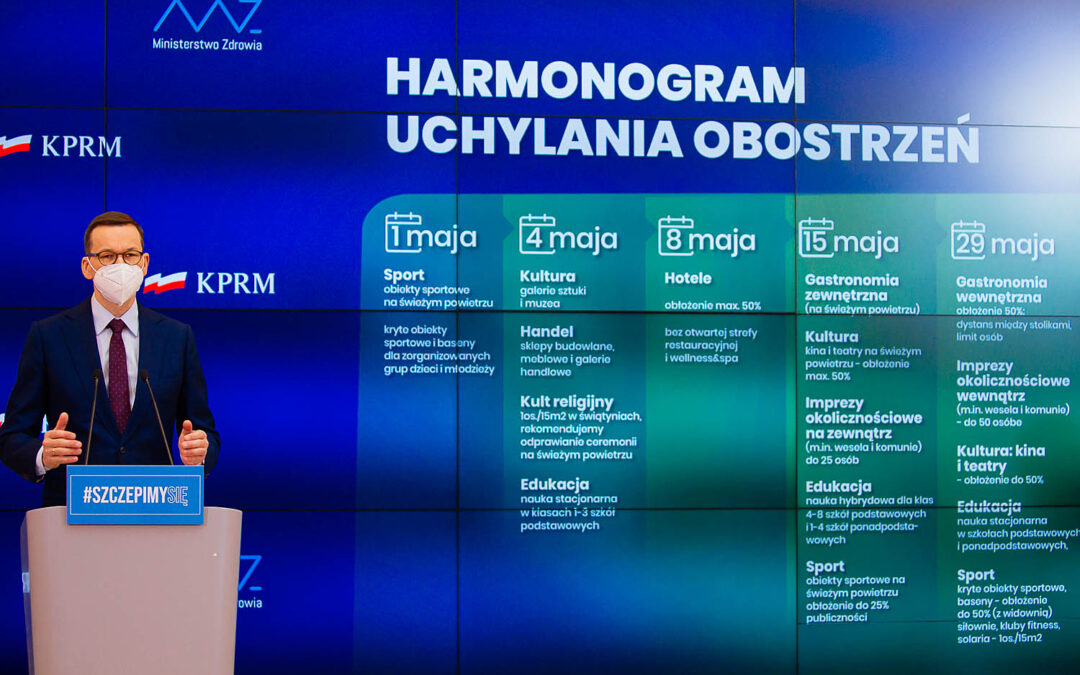Poland’s government has unveiled a timetable for removing coronavirus restrictions – which have been in place for most of the time since last October – next month.
Announcing the schedule, Prime Minister Mateusz Morawiecki said that the loosening was made possible by the decline in infections since the start of April and the rollout of vaccines, which has already seen some restrictions removed.
However, while there is room for “grounds for cautious optimism [that] the worst is probably behind us”, he warned that the government would still have to be “flexible” if the situation worsens.
The timetable unveiled today is as follows:
1 May
- Limit on number of people who can practise outdoor sport increased to 50 (up from 25 currently)
- Reopening of indoor sports facilities, including swimming pools, for organised groups of children and youth
4 May
- Years 1 to 3 in primary schools return to full-time in-person teaching (as opposed to current “hybrid” learning combining in-person and remote teaching)
- Art galleries and museums to reopen with limit of 1 person per 15 m2
- Construction and furniture stores and shopping centres to reopen with limit of 1 person per 15 m2
- Limit on number of people who can attend religious services increased to 1 per 15 m2 (up from 1 per 20 m2 currently)
8 May
- Hotels to reopen with maximum 50% occupancy and restaurants and spa/wellness facilities remaining closed
15 May
- Restaurants to reopen for outdoor dining
- Outdoor cinemas and theatres to reopen with maximum 50% occupancy
- Events (such as weddings) to resume outdoors with up to 25 people in attendance
- Years 4 to 8 of primary schools and 1 to 4 of secondary schools to return to hybrid learning
- Audiences allowed at outdoor sports events (up to 25% of capacity)
- Obligation to wear masks in outdoor public spaces lifted if the infection rate per 100,000 people has fallen below 15
29 May
- Restaurants to open for indoor dining with up to 50% occupancy
- Events (such as weddings) allowed to resume indoors with up to 50 people in attendance
- Indoor cinemas and theatres to reopen with maximum 50% occupancy
- Indoor sports facilities, including swimming pools, to reopen for all up to 50% capacity
- All school pupils to return to in-person learning
🟢 Przy utrzymującym się niskim poziomie zakażeń możliwe będzie stopniowe luzowanie obostrzeń według zaplanowanego harmonogramu.
⚠️ Harmonogram może zmieniać się w zależności od aktualnej sytuacji epidemicznej.
Sprawdź, jak wygląda plan na maj ▶️ https://t.co/VbfPj67HEJ pic.twitter.com/BEBwBFkNm5
— Kancelaria Premiera (@PremierRP) April 28, 2021
Morawiecki called on the public to show “patience” with the gradual easing of restrictions. “The virus won’t go away overnight,” he warned. He also emphasised that it was vital for people to keep registering to receive vaccines, as this is the best way to help “our economy return to normality as soon as possible”.
However, some commentators expressed concern that the restrictions were being rolled back too quickly, given that death and hospitalisation numbers, though falling, remain high.
“Announcing an optimistic plan to lift most restrictions on a day when there were 636 [Covid-related] deaths is quite a bold move,” tweeted Michał Szyłdrzyński, deputy editor-in-chief of centre-right daily Rzeczpospolita.
Main image credit: Krystian Maj/KPRM (under CC BY-NC-ND 2.0)

Daniel Tilles is editor-in-chief of Notes from Poland. He has written on Polish affairs for a wide range of publications, including Foreign Policy, POLITICO Europe, EUobserver and Dziennik Gazeta Prawna.




















